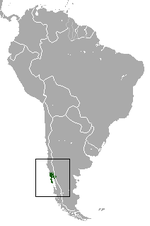Chilean possum mouse
| Chilean possum mouse | ||||||||||||
|---|---|---|---|---|---|---|---|---|---|---|---|---|
| Systematics | ||||||||||||
|
||||||||||||
| Scientific name of the genus | ||||||||||||
| Rhyncholestes | ||||||||||||
| Osgood , 1924 | ||||||||||||
| Scientific name of the species | ||||||||||||
| Rhyncholestes raphanurus | ||||||||||||
| Osgood , 1924 |
The Chilean Opossummaus ( Rhyncholestes raphanurus ) is a Beutelsäugerart from the family of shrew opossum (Caenolestidae). It is placed in its own genus ( Rhyncholestes ) and is therefore monotypical . It is native to the Chilean island of Chiloé and the adjacent mainland and thus has the southernmost distribution area of its family.
description
The Chilean opossum mouse is characterized by its elongated snout, which gives it a rat - or shrew - like appearance. Their thick, soft fur is dark brown and their short, hairless tail is black. These animals reach a head body length of 11 to 13 centimeters, a tail length of 7 to 9 centimeters and a weight of around 21 grams.
Way of life
These animals live in cool rainforests up to 1100 meters above sea level. They lead a ground-dwelling life and are likely to be nocturnal. Animals that were found in autumn often had a thickened tail, which is an indication of fat storage for rigid winter ( torpor ). They feed on insects, worms and fungi, and they often dig for food in the earth or in foliage.
Little is known about social behavior and reproduction. The females have seven teats, six in a circle and one in the middle. Suckling females were found nearly all year round.
threat
The main threat to the Chilean opossum mouse is the clearing of the forests. The International Union for Conservation of Nature ( IUCN) therefore lists them in the Red List of Threatened Species as Near Threatened .
literature
- Ronald M. Nowak: Walker's Mammals of the World . Johns Hopkins University Press, 1999 ISBN 0-8018-5789-9
Web links
- Rhyncholestes raphanurus in the endangered Red List species the IUCN 2009. Posted by: Diaz M. & Teta, P., 2008. Accessed on March 14 of 2010.
